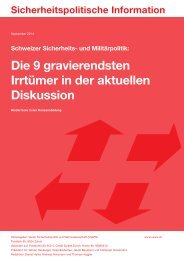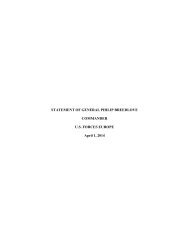FULLTEXT01
FULLTEXT01
FULLTEXT01
Create successful ePaper yourself
Turn your PDF publications into a flip-book with our unique Google optimized e-Paper software.
TACTICAL THOUGHT<br />
2014 September 29 th<br />
The most observable result is that unit type, backgrounds and affiliation follow the<br />
value/capital structure according to axis 1 for ranger and infantry unit officers, however,<br />
not regarding officers with a mechanized background. In all, it can be said that<br />
distributions of different value possessions can be identified, but also that some<br />
indications are difficult to analyse. The result does however show that background<br />
factors, with different value recognitions can be found structured in various patterns,<br />
also in the space of statements referring to tactics in Irregular Warfare. Such analysis<br />
has not yet been a part of Swedish War Studies traditions.<br />
The space of tactical thought as statements 180 obtained by the sample of field<br />
commanders contains several different structural indications. We can identify different<br />
tactical preferences in the same context (of Irregular Warfare) that are possible to link to<br />
different sociological aspects. We can connect to a generalized value structure, and<br />
identify certain distribution trends of background factors, all in the same space of<br />
statements. Difficulties in the ability to draw conclusions do however exist. The<br />
structure of the space of statements has stronger data support than the background factor<br />
ones. Nonetheless, differences in tactical preferences have been shown, as indications of<br />
background factor structuring signs in a value/capital context. Differences exist, and<br />
differences matter, especially when values are questioned and threatened. It is a<br />
commonly known fact that frictions and struggles occur when economic interests clash<br />
with different values of tactics and unit development needs. Potentiality for interest<br />
struggles is also of obvious importance for launching new ideas and creative<br />
development enterprises.<br />
The Bourdieu concept of field is possible to be used to discuss differences in<br />
standpoints and relations to background factors connected to properties which can<br />
reveal characteristics of the space. Two perspectives thus emerge. First, if the space of<br />
standpoints can be argued to contain some relational characteristics. In this case, the aim<br />
is to identify social groupings sharing the same values that oppose other groupings. In<br />
short, if relational structures can be indicated and their properties identified. In such a<br />
case, indications of a potentiality for tactical development struggles are possible to be<br />
described. The previous discussion identified properties relating to unit types,<br />
backgrounds and affiliation and international experiences of certain character, with a<br />
distribution of certain tactical types. However, the character of the sample consisting of<br />
field officers working hard with current unit training, production and structural<br />
transformation, is probably less likely to generate time consuming interest struggles in<br />
tactics.<br />
180 The space of statements is described as follows. Axis 1; Two different ranges of tactical thought,<br />
mainly with equal focus on larger or smaller, or a more distinct focus on smaller units. Distributed tactics<br />
with a combination of reconnaissance and combat concepts/capabilities are prioritized. Opposite, we find<br />
larger units collectively operating with a clearer combat conceptual focus. These variations are argued to<br />
belong to the conceptual sphere of thinking (or capability needs; “how to act”). Axis 2; Two different<br />
ranges of tactical thought are identified. The first; regarding thought of primarily military tasks and<br />
kinetic effects. Secondly; a broader thought of military and civilian tasks or mainly of civilian tasks. Here,<br />
the focus is on non-kinetic or a combination of kinetic and non-kinetic effects. These positions are<br />
suggested to belong to a contextual sphere of thinking (or in terms of operational/tactical environment;<br />
“where to act”).<br />
88





